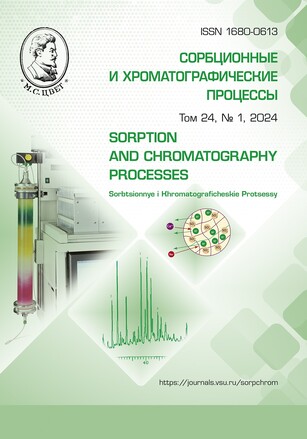Application of the thin layer chromatography method for the determination of the degree of hydrolysis of soy lecithin
Abstract
The aim of this study was the determination of the degree of enzymatic hydrolysis of soy lecithin using thin layer chromatography in combination with a modern imaging data processing program. Hydrolysis of phospholipids was carried by the action of the enzyme phospholipase A2 (PLA2) in the presence of calcium ions for 2 h at a temperature of 50°C and pH 5.7. Chromatographic separation of the components of the reaction medium was carried out 10, 20, 30, 60, 90, and 120 min after adding the PLA2 in the chloroform: methanol: ammonium hydroxide system in a ratio of 6.5 : 2.5 : 0.4 (v/v/v). The following phospholipids and their lysoforms were identified: Rf = 0.41±0.03 for phosphatidylethanolamine (PE), Rf = 0.28±0.02 for phosphatidylcholine (PC), Rf = 0.09±0.01 for phosphatidylinositol (PI), Rf = 0.06±0.01 for phosphatidic acid (PA), Rf = 0.15±0.02 for lysophosphatidylethanolamine (LPE), Rf = 0.08±0.01 for lysophosphatidylcholine (LPC), Rf = 0.03±0.01 for lysophosphatidylinositol (LPI) and Rf = 0.02±0.01 for lysophosphatidic acid (LPA). It was shown that soy lecithin contained PC, PE, PI, and PA before the enzymatic reaction, the content of these compounds after the addition of the PLA2 decreases due to the formation of LPC, LPE, LPI, and LPA, respectively. The dependence of the degree of hydrolysis (α, %) of PC on the duration of the enzymatic reaction was obtained. It was established that the intensive conversion of PC to LPC under the action of the PLA2 occurred during 60 min (α = 82%). Further conversion of PC occurred insignificantly: 84% after 90 min and 87% after 120 min, which was due to the inhibition of enzyme activity by the final reaction product.
Downloads
References
Zharkova I.M., Rudakov O.B., Poljanskij K.K., Rosljakov Ju.F. Lecitiny v tehnologijah produktov pitanija. Voronezh, VGUIT, 2015, 256 p. (In Russ.)
Hwang H., Chun H., Kim D., Shin M., Kim Y., In S., Kim T., Kang N., Lysophosphatidylcholine exerts an anti‐skin photoaging effect via heat shock protein 70 induction, J. Cosmet. Dermatol., 2021; 20(12): 4060-4067. https://doi.org/10.1111/jocd.14068
Ahmmed M.K., Hachem M., Ahmmed F., Rashidinejad A., Oz F., Bekhit A.A., Carne A., Bekhit A.E.-D.A., Marine fish-derived lysophosphatidylcholine: properties, extraction, quantification, and brain health application, Molecules, 2023; 28(7): 3088. https://doi.org/10.3390/molecules28073088
Brautigan D.L., Li R., Kubicka E., Turner S.D., Garcia J.S., Weintraut M.L., Wong E.A., Lysolecithin as feed additive enhances collagen expression and villus length in the jejunum of broiler chickens, Poult. Sci., 2017; 96(8): 2889-2898. https://doi.org/10.3382/ps/pex078
Wu Y., Wang T., Soybean lecithin fractionation and functionality, J. Am. Oil Chem. Soc., 2003; 80(4): 319-326. https://doi.org/10.1007/s11746-003-0697-x
Murakami M., Taketomi Y., Sato H., Yamamoto K., Secreted phospholipase A2 revisited, J. Biochem., 2011; 150(3): 233-255. https://doi.org/10.1093/jb/mvr088
Ivanusec A., Sribar J., Krizaj I., Secreted phospholipases A2 – not just enzymes: revisited, Int. J. Biol. Sci., 2022; 18(2): 873-888. https://doi.org/10.7150/ijbs.68093
Kim R.R., Chen Z., Mann T.J., Bastard K., Scott K.F., Church W.B., Structural and functional aspects of targeting the secreted human group IIA phospholipase A2, Molecules, 2020; 25(19): 4459. https://doi.org/10.3390/molecules25194459
Jain M.K., Berg O.G., Coupling of the i-face and the active site of phospholipase A2 for interfacial activation, Curr. Opin. Chem. Biol., 2006; 10(5): 473-479. https://doi.org/10.1016/j.cbpa.2006.08.015
Alekseeva A.S., Boldyrev I.A., Fosfolipaza A2. Metody monitoringa aktivnosti, Biologicheskie membrany: Zhurnal membrannoj i kletochnoj biologii, 2020; 37(5): 323-336. https://doi.org/10.31857/S0233475520050035 (In Russ.)
Litvinko N.M., Gidroliz UF-inducirovannogo perekisno-okislennogo fosfatidilholina fosfolipazami raznoj substratnoj specifichnosti, Izvestija Nacional'noj akademii nauk Belarusi. Serija himicheskih nauk, 2021; 57(2): 195-205. https://doi.org/10.29235/1561-8331-2021-57-2-195-205 (In Russ.)
Mouchlis V.D., Bucher D., McCammon J.A., Dennis E.A., Membranes serve as allosteric activators of phospholipase A2, enabling it to extract, bind, and hydrolyze phospholipid substrates, Proc. Natl. Acad. Sci. U.S.A., 2015; 112(6): 516-525. https://doi.org/10.1073/pnas.1424651112
Safonova E.F., Nazarova A.A., Selemenev V.F., Brezhneva T.A., Slivkin A.I., Vybor optimal'nyh parametrov razdelenija fosfolipidov v tonkom sloe sorbenta, Himiko-farmacevticheskij zhurnal, 2002; 36(4): 41-43. https://doi.org/10.30906/0023-1134-2002-36-4-41-43 (In Russ.)
Dynska-Kukulska K., Ciesielski W., Methods of extraction and thin-layer chromatography determination of phospholipids in biological samples, Rev. Anal Chem., 2012; 31(1): 43-56. https://doi.org/10.1515/revac-2011-0030
Kogan Ju.D., Gol'cberg M.A., Otechestvennoe oborudovanie dlja kolichestvennoj tonkoslojnoj hromatografii, Rossijskij himicheskij zhurnal, 2003; 47(1): 136-140. (In Russ.)
Maljavina V.V., Primenenie programmnyh sredstv vizualizacii i obrabotki dannyh TSH-analiz pri proizvodstve fosfolipidnyh produktov, Farmacija, 2003; 2: 26-30. (In Russ.)
Avanti Polar Lipids. TLC solvent systems – lipid migration. Available at: https://avantilipids.com/tech-support/analytical-procedures/tlc-solvent-systems (accessed 4 May 2023).
Kates M. Tehnika lipidologii. Vydelenie, analiz i identifikacija lipidov. M., Mir Publ., 1975, 322 p.
Sikorskaja A.S., Nazarova A.A., Selemenev V.F., Podbor optimal'nyh uslovij razdelenija fosfolipidnyh kompleksov, poluchennyh iz semjan podsolnechnika, Sorbcionnye i hromatograficheskie processy, 2009; 9(2): 215-220. (In Russ.)
Helmerich G., Koehler P., Comparison of methods for the quantitative determination of phospholipids in lecithins and flour improvers, J. Agric. Food Chem., 2003; 51(23): 6645-6651. https://doi.org/10.1021/jf0345088







